Teaching and Training Program
undergraduate
 |
 |
 |
 |
GEMOC's teaching program aims to:
• provide undergraduate and postgraduate students with a broad, integrative understanding of Earth architecture and processes, bridging the discipline boundaries of geology and geophysics
• train undergraduate and postgraduate students in new conceptual approaches and the applications of advanced technology, including geochemical analysis techniques and the integrated field and laboratory use of geographic information systems (GIS)
• develop international links in teaching programs (especially postgraduate) relevant to GEMOC's goals
• develop formal tailored course work components at postgraduate level which also can be packaged for distance education delivery and as short courses available to the mining industry
• enhance the pool of high quality geoscience graduates by restructuring academic programs to attract a new clientele
HIGHLIGHTS 2005
Curriculum Development
- Once again our tailored problem-based learning (TPBL) units GEOS116 Marine Geoscience and GEOS115 Earth Dynamics, Materials and the Environment were well received by students.
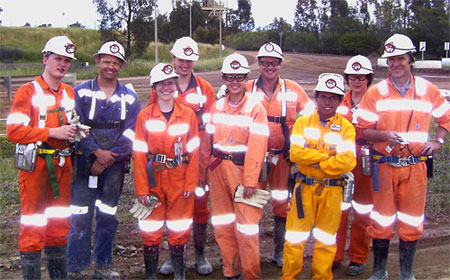 This format, which includes lectures, problem-based workshops and traditional skill-based practicals is designed to encourage the students to become more active learners and to develop a range of generic skills. The workshops are completed as group work projects and the students are required to produce scientific reports based on the results of their investigations. Generic skills developed include teamwork, problem-solving, critical thinking and written and verbal communication.
This format, which includes lectures, problem-based workshops and traditional skill-based practicals is designed to encourage the students to become more active learners and to develop a range of generic skills. The workshops are completed as group work projects and the students are required to produce scientific reports based on the results of their investigations. Generic skills developed include teamwork, problem-solving, critical thinking and written and verbal communication.
GEOS314 students and Dr Simon Jackson reflecting on their field trip to the Northparkes Cu-Au mine in October 2005.
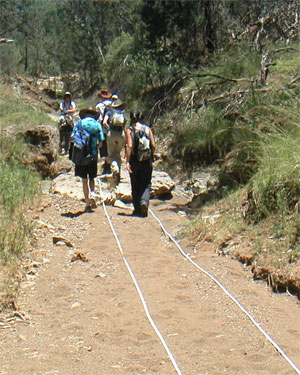
- GEOS230 Field and Laboratory Studies in Geoscience was run successfully in 2005, including being offered externally for the first time. This new unit uses projects integrated with lectures and laboratory classes to develop the theoretical knowledge and hands-on experience needed to map, describe and interpret rocks (and other materials – eg soils, fossils, etc) in the field and the laboratory. One popular component of the unit is a forensic science murder mystery where an academic staff member has been murdered and three other staff are the key suspects! Many arguments ensue amongst the students over who did it. This type of project increases the student engagement with the unit content and leads to better retention of the key concepts. Once again the unit included a field trip to the historic gold mining town of Hill End.
- GEOS307 Field Geology and Mapping was run by Dr David Durney in 2005 for last time before he retires, bringing the end of an era. Field studies near Eugowra in the Forbes region of NSW allowed students to gain experience mapping deformed and varied geological units. The unit will return to the Broken Hill region in 2006.
- A number of students attended the GEOS381 Special Interest Seminar field trip to New Caledonia in 2005 run jointly with The School of Geosciences at The University of Sydney. They enjoyed great weather. The highlight of the trip was the spectacular exposures of blueschist and eclogite in the NE of New Caledonia.
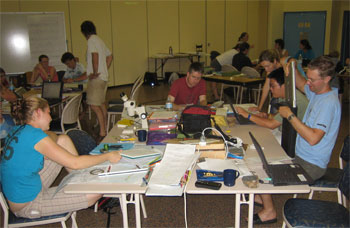
- Our portable computer lab was upgraded in 2005 with the purchase of new laptop computers. This facility allows students access to up-to-date computer software for use in both the classroom and field. The use of computer packages and web interfaces in Earth and Planetary Sciences continues as a routine feature of content and skills delivery. Both geology and geophysics units incorporate packages used by industry into classroom and field teaching.
GEOS224 field trip to Lake Keepit, December.
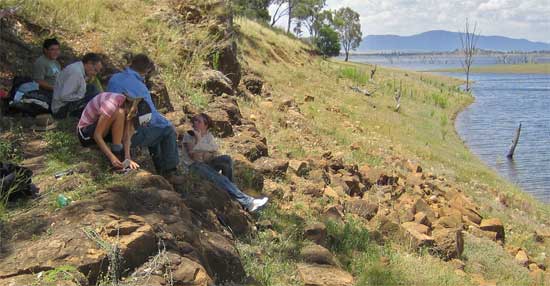
Geophysics teaching progress 2005
- The named degree, Bachelor of Geophysics, continued in 2005 after its inception in 1998 to increase the visibility of Geophysics. It has evolved into the advanced geophysics stream in the Bachelor of Science degree.
- The Bachelor of Technology in Exploration Geoscience has a Geophysics strand initiated in 1999, streamed from second year level (see flow sheet in Appendix 6).
- Use of an extensive pool of GPS units for undergraduate (and postgraduate) fieldwork continued.
- Extended implementation of new seismic, gravity GPS and resistivity equipment for student field projects in exploration, groundwater, environmental and engineering geophysics.
- Equipment upgrades funded by Macquarie University over the last five years have resulted in an excellent array of new instrumentation. Acquisitions include:
- GEOMETRICS G856 Proton Precession Magnetometer
- GEOSOFT, MODELVISION, EMVISION, ERMAPPER, SeisImager and Claritas software was either purchased or upgraded
- Seismic trigger cable modifications
- ABEM SAS4000 Resistivity System and an ABEM LUND system
- ASHTECH Z-Xtreme Differential GPS system
- DUALEM Frequency Domain EM System

Outcomes
The introduction of new units and restructuring of existing undergraduate units at Macquarie as described in each Annual Report has achieved the goals of attracting new clientele. However, this is within an environment of a contracting pool of science undergraduates. Despite this, GEMOC core units at 100 level have maintained enrolment levels. Reorganisation of course structures and acquisition of teaching infrastructure (computers, high-technology instruments, GIS units) have increased the visibility of geoscience and have resulted in the presentation of geoscience with an interdisciplinary and innovative approach using state-of-the art technology and concepts.
GEMOC honours
The following honours projects in GEMOC were completed 2005:
Martyn Allen: An investigation of the subsurface structure of the Mole Granite using geophysical techniques
Stephanie Carroll: Plutonism and metamorphism at the root of a Cretaceous magmatic arc, Fiordland, New Zealand
Zoe Demidjuk: U-Series insights into melting processes and magma evolution beneath the Newer Volcanics Province, South Australia
Glenn Gooch: An investigation of the gravity signature of the Hunter Thrust, Singleton, N.S.W.
Kirsty Liddicoat: Geology and geochemistry of the Lightning Ridge black opal deposits
Penelope Littlewood: The mineralogy and geochemistry of the Phoenix tungsten deposit, near Frogmore NSW
Dania Perez: An EMP and LAM-ICPMS study of the Carboniferous glassy volcanic rocks of the Tamworth Belt
Alice Plioplis: Facies analysis, geochemistry and tectonic setting of the Frampton Volcanics
Heather Skeen: Applying geophysical techniques in grave detection
Natalie Staib: The geophysical expression of Tertiary igneous activity at Mt Tabor, South-Central Queensland
The following Honours projects are relevant to GEMOC in 2006:
Cara Danis: The 3D upper crustal structure of the Wongwibinda Complex, New England Fold Belt: a tilted block?
Nicole Harb: Facies analysis, fragmentation processes and depositional mechanisms of hyaloclastite breccias, Macquarie Island
Peter Caffi: Fabric development and finite strain patterns in a metamorphic dome bounding shear zone, Dayman-Suckling Dome, Papuan Peninsula, Eastern
GEMOC postgraduate
 |
 |
 |
 |
See advertisement for GEMOC postgraduate opportunities, Appendix 7.
GEMOC's active international exchange program continued, including the program with the University of Jean Monnet, St Etienne. Stéphanie Touron’s successful thesis defence was held in August and June Chevet commenced a new co-tutelle PhD project.

The postgraduate seminar series gives important training in public presentation of results.
completed
Olivier Alard (PhD): Trace element geochemistry and mantle domains, emphasis on PGE and Re/Os; IPRS with MUIPRA stipend (graduated 2001)
Kari Anderson (PhD): Defining the APWP for early to mid Palaeozoic eastern Gondwanaland: paleomagnetic pole information from the northern Tasman Orogen; IPRS with MUIPRA stipend (graduated 2003)
Sonja Aulbach (PhD): Depletion and metasomatic processes in cratonic mantle; IPRS with MUIPRA stipend (graduated 2004)
Elena Belousova (PhD): Zircon and apatite geochemistry: applications to petrology and mineral exploration; APA and sponsorship by Rio Tinto (graduated 2000)
Eloise Beyer (PhD): Contrasting characteristics of Proterozoic and Phanerozoic mantle types; Field assistance from Ashton Mining (graduated 2003)
Rondi Davies (PhD): East Australian Diamonds: Characterisation and origin; Sponsored by Rio Tinto, Kennecott Canada (graduated 1999)
Guillaume Delpech (PhD): Isotopic characteristics of lithosphere processes beneath Kerguelen; Co-tutelle with University of Jean Monnet, IPRS with GEMOC stipend and EURODOC scholarship (graduated 2005)
Oliver Gaul (PhD): Composition of the lithospheric mantle beneath Australia; APAI collaborative with Stockdale Prospecting, CSIRO EM (graduated 2000)
Bin Guo (PhD): An integrated geophysical investigation of the Hunter-Mooki and Peel Fault; IPRS with MUIPRA stipend (graduated 2005)
Joanne McCarron (MSc): Mantle xenoliths from Queensland and South Australia (graduated 1997)
Bertrand Moine (PhD): The role of fluids in the genesis, segregation and crystallisation of intraplate oceanic mantle magmas: implications for crustal accretion; Co-tutelle with University of Jean Monnet (graduated 2000)
Mark Pirlo (PhD): Australian groundwater geochemistry; applications to heat flow and exploration; APA and Queen’s Trust for Young Australians Award (graduated 2003)
Esmé van Achterbergh (PhD): Trace-element fingerprints of metasomatic processes in lithospheric mantle (graduated 2005)
Shixin Yao (PhD): Chromite as a petrogenetic indicator in ultramafic rocks; Collaborative with Rio Tinto (graduated 2000)
Xu Xisheng (PhD): The lithospheric mantle beneath eastern China; Formal exchange PhD, Nanjing and Macquarie (graduated 2000)
current
Brad Bailey (PhD): Law Dome: Ice and crust mass balance studies (commenced 2004) (see Research Highlights)
Jacques Batumike (PhD): The origin of kimberlites from the Kundelungu region (D.R. Congo) and the nature of the underlying lithospheric mantle (commenced 2005)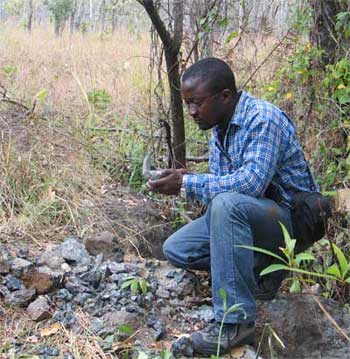
Jacques Batumike...D.R. Congo fieldwork 2005.
Stephanie Carroll (PhD): The mechanisms and deep-crustal controls on continental rifting (commenced 2005)
June Chevet (PhD): Gabbroic rocks from the Kerguelen Islands (Indian Ocean): a petrologic, geochemical and isotopic investigation of their origin (commenced 2004)
Steven Cooper (PhD): Diamonds and mantle-derived minerals, NW Australia and South Australia (commenced part time 2003)
Heather Cunningham (PhD): A U-series isotope study of magma residence times, degassing and petrogenesis of Rabaul Caldera, Papua New Guinea (commenced 2005)
Kathleen McMahon (PhD): Fracturing and deformation along the Amery Ice Shelf: A seismic study (commenced 2004)
Luke Milan (PhD): The emplacement, pressure-temperature-time path and structural evolution of lower crustal gneisses in Fiordland, New Zealand (commenced 2004)
Valeria Murgulov (PhD): Crust-mantle evolution and metallogeny, eastern Australia; APA (commenced 2003)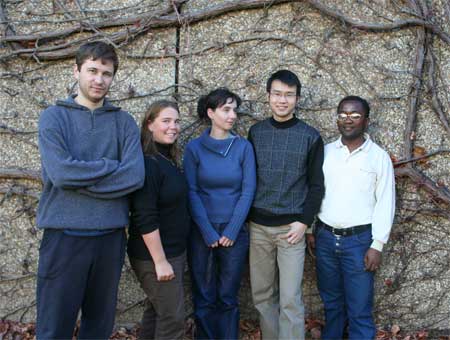
Nenad Nikolic (PhD): Evolution of crust-mantle systems near a young rift: NW Spitsbergen, Norway (commenced 2004)
Kathlene Oliver (MSc): Depth and subsurface shape of the Dundee Ignimbrite (part-time, commenced 2001)
Will Powell (PhD): Nature of the lithospheric mantle in the New England Region, NSW; APA (part-time, commenced 1997, submitted 2005)
Sonal Rege (PhD): Trace-element geochemistry of diamonds; IPRS with iMURS scholarship (commenced 2002, submitted 2005) (see Research Highlights)
Stéphanie Touron (PhD): Geochemical fingerprints of the mantle beneath the Massif Central; IPRS with MURAACE scholarship (commenced 2001, submitted 2005)
Some of GEMOC's 2005/6 postgraduate students. Above: Nenad Nikolic, Heather Cunningham, June Chevet, Weiqiang Li, and Jacques Batumike; Below: John Caulfield, Kathleen McMahon, Brad Bailey, Luke Milan, Alan Kobussen, Valeria Murgulov, and Ryan Portner.commencing 2006
John Caulfield (PhD): Tofua volcano- Tonga Arc, Eruption history and timescales of Magma Chamber Processes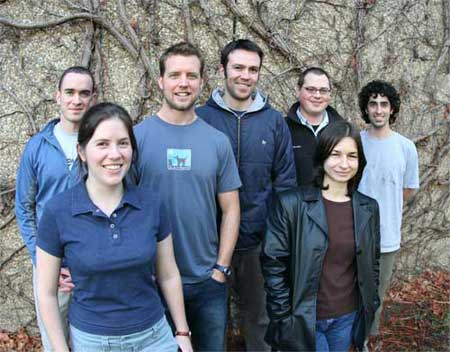
David Clark (PhD): Application of magnetic methods to a range of problems in Earth Sciences
Abhijit Deonath (PhD): The early Palaeozoic tectonic evolution of the northern Lachlan Orogen (part-time)
Weiqiang Li (PhD): Stable metal isotope geochemistry of the Cadia and Northparkes porphyry Cu-Au deposits
Alan Kobussen (PhD): Composition, structure, and evolution of the lithospheric mantle beneath Southern Africa
Ryan Portner (PhD): Spreading ridge sedimentation processes: a novel approach using Macquarie Island as a natural laboratory

 GEMOC ARC National Key Centre
GEMOC ARC National Key Centre